sensor Peugeot Expert VU 2009 Owner's Manual
[x] Cancel search | Manufacturer: PEUGEOT, Model Year: 2009, Model line: Expert VU, Model: Peugeot Expert VU 2009Pages: 226, PDF Size: 10.49 MB
Page 3 of 226
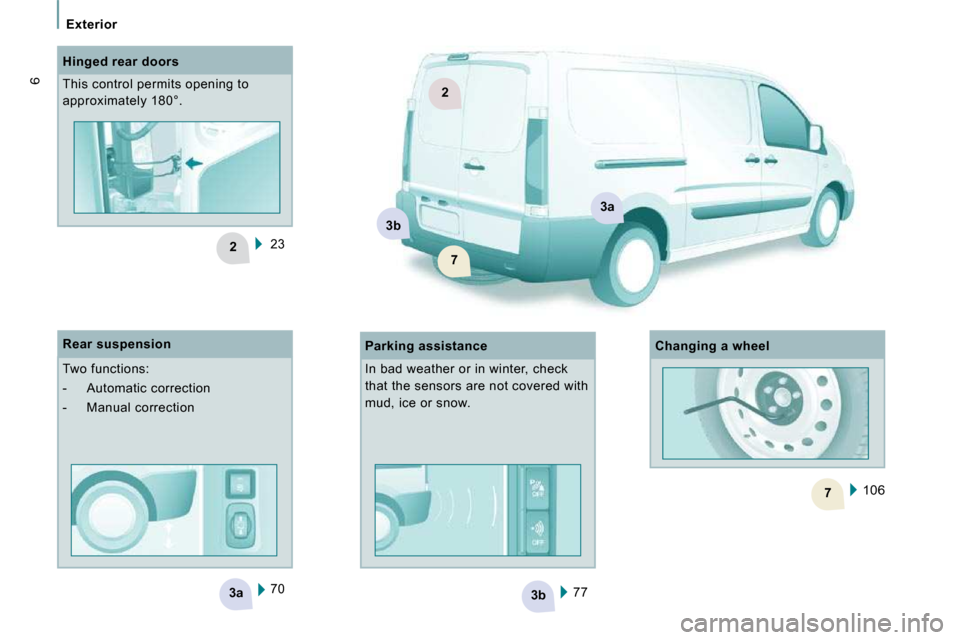
3b3a
2
7
2
3a
3b
7
Exterior
6
77
70
Hinged rear doors
This control permits opening to
approximately 180°.
Parking assistance
Rear suspension
Two functions:
- Automatic correction
- Manual correction
106
Changing a wheel
23
In bad weather or in winter, check
that the sensors are not covered with
mud, ice or snow.
Page 33 of 226
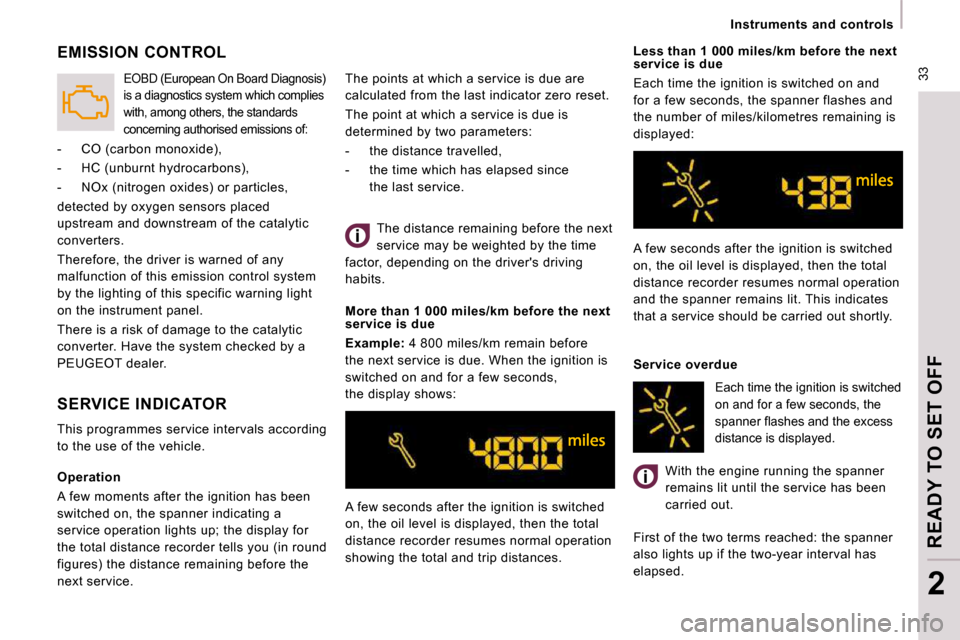
33
Instruments and controls
READY TO SET OFF
2
Operation
A few moments after the ignition has been
switched on, the spanner indicating a
service operation lights up; the display for
the total distance recorder tells you (in round
figures) the distance remaining before the
next service. A few seconds after the ignition is switched
on, the oil level is displayed, then the total
distance recorder resumes normal operation
showing the total and trip distances. Less than 1 000 miles/km before the next
service is due
Each time the ignition is switched on and
for a few seconds, the spanner flashes and
the number of miles/kilometres remaining is
displayed:
A few seconds after the ignition is switched
on, the oil level is displayed, then the total
distance recorder resumes normal operation
and the spanner remains lit. This indicates
that a service should be carried out shortly.
Service overdue
With the engine running the spanner
remains lit until the service has been
carried out.
First of the two terms reached: the spanner
also lights up if the two-year interval has
elapsed.
The distance remaining before the next
service may be weighted by the time
factor, depending on the driver's driving
habits.
More than 1 000 miles/km before the next
service is due
Example: 4 800 miles/km remain before
the next service is due. When the ignition is
switched on and for a few seconds,
the display shows:
SERVICE INDICATOR
This programmes service intervals according
to the use of the vehicle.
EMISSION CONTROL
- CO (carbon monoxide),
- HC (unburnt hydrocarbons),
- NOx (nitrogen oxides) or particles,
detected by oxygen sensors placed
upstream and downstream of the catalytic
converters.
Therefore, the driver is warned of any
malfunction of this emission control system
by the lighting of this specific warning light
on the instrument panel.
There is a risk of damage to the catalytic
converter. Have the system checked by a
PEUGEOT dealer.
EOBD (European On Board Diagnosis)
is a diagnostics system which complies
with, among others, the standards
concerning authorised emissions of:
Each time the ignition is switched
on and for a few seconds, the
�s�p�a�n�n�e�r� �fl� �a�s�h�e�s� �a�n�d� �t�h�e� �e�x�c�e�s�s�
distance is displayed.
The points at which a service is due are
calculated from the last indicator zero reset.
The point at which a service is due is
determined by two parameters:
- the distance travelled,
- the time which has elapsed since the last service.
Page 34 of 226
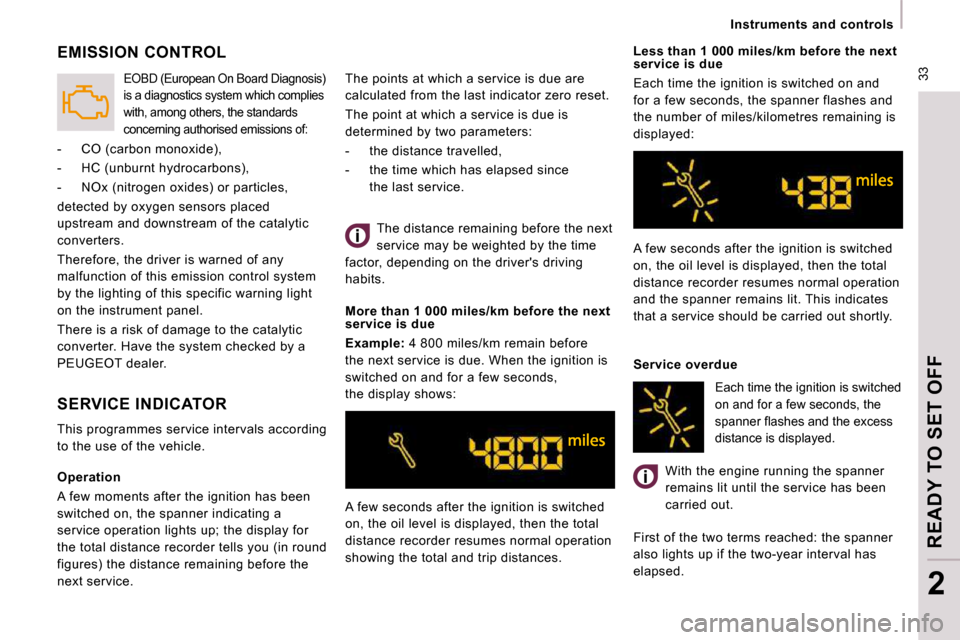
33
Instruments and controls
READY TO SET OFF
2
Operation
A few moments after the ignition has been
switched on, the spanner indicating a
service operation lights up; the display for
the total distance recorder tells you (in round
figures) the distance remaining before the
next service. A few seconds after the ignition is switched
on, the oil level is displayed, then the total
distance recorder resumes normal operation
showing the total and trip distances. Less than 1 000 miles/km before the next
service is due
Each time the ignition is switched on and
for a few seconds, the spanner flashes and
the number of miles/kilometres remaining is
displayed:
A few seconds after the ignition is switched
on, the oil level is displayed, then the total
distance recorder resumes normal operation
and the spanner remains lit. This indicates
that a service should be carried out shortly.
Service overdue
With the engine running the spanner
remains lit until the service has been
carried out.
First of the two terms reached: the spanner
also lights up if the two-year interval has
elapsed.
The distance remaining before the next
service may be weighted by the time
factor, depending on the driver's driving
habits.
More than 1 000 miles/km before the next
service is due
Example: 4 800 miles/km remain before
the next service is due. When the ignition is
switched on and for a few seconds,
the display shows:
SERVICE INDICATOR
This programmes service intervals according
to the use of the vehicle.
EMISSION CONTROL
- CO (carbon monoxide),
- HC (unburnt hydrocarbons),
- NOx (nitrogen oxides) or particles,
detected by oxygen sensors placed
upstream and downstream of the catalytic
converters.
Therefore, the driver is warned of any
malfunction of this emission control system
by the lighting of this specific warning light
on the instrument panel.
There is a risk of damage to the catalytic
converter. Have the system checked by a
PEUGEOT dealer.
EOBD (European On Board Diagnosis)
is a diagnostics system which complies
with, among others, the standards
concerning authorised emissions of:
Each time the ignition is switched
on and for a few seconds, the
�s�p�a�n�n�e�r� �fl� �a�s�h�e�s� �a�n�d� �t�h�e� �e�x�c�e�s�s�
distance is displayed.
The points at which a service is due are
calculated from the last indicator zero reset.
The point at which a service is due is
determined by two parameters:
- the distance travelled,
- the time which has elapsed since the last service.
Page 39 of 226
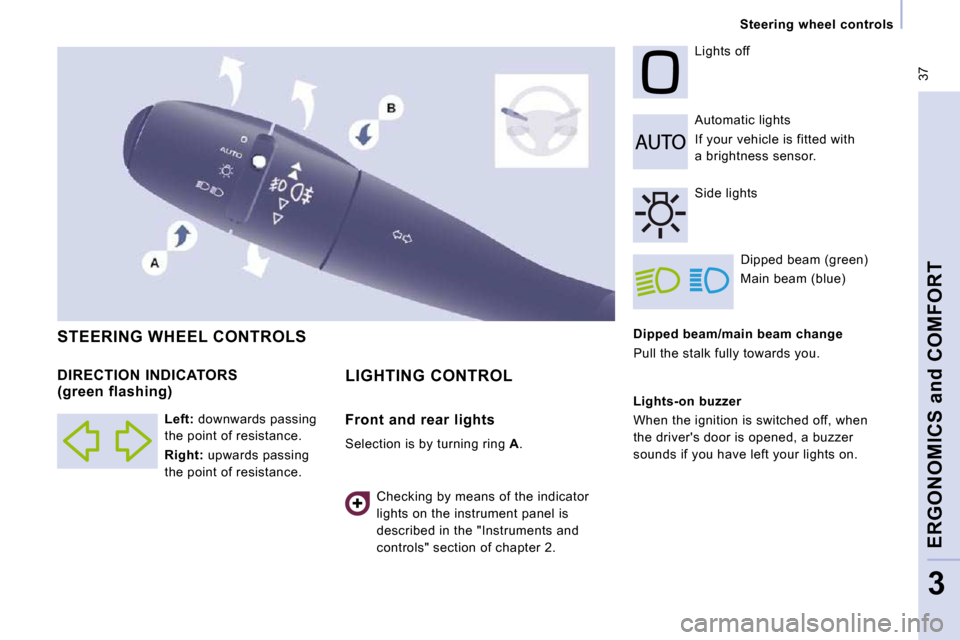
37
Steering wheel controls
ERGONOMICS and COMFORT
3
Dipped beam/main beam change
Pull the stalk fully towards you. Automatic lights
If your vehicle is fitted with
a brightness sensor.
Lights off
Dipped beam (green)
Main beam (blue)
DIRECTION INDICATORS
(green flashing) STEERING WHEEL CONTROLS
Checking by means of the indicator
lights on the instrument panel is
described in the "Instruments and
controls" section of chapter 2. Side lights
Lights-on buzzer
When the ignition is switched off, when
the driver's door is opened, a buzzer
sounds if you have left your lights on.
Left: downwards passing
the point of resistance.
Right: upwards passing
the point of resistance.
LIGHTING CONTROL
Front and rear lights
Selection is by turning ring A .
Page 41 of 226
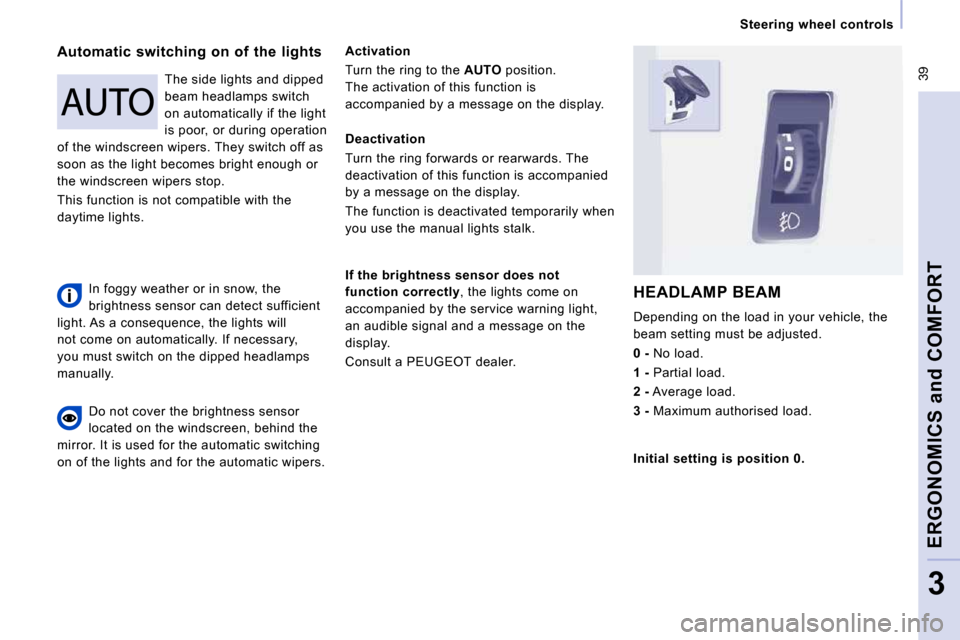
39
Steering wheel controls
ERGONOMICS and COMFORT
3
Automatic switching on of the lights Activation
Turn the ring to the
AUTO position.
The activation of this function is
accompanied by a message on the display.
If the brightness sensor does not
function correctly , the lights come on
accompanied by the service warning light,
an audible signal and a message on the
display.
Consult a PEUGEOT dealer.
HEADLAMP BEAM
Depending on the load in your vehicle, the
beam setting must be adjusted.
0 - No load.
1 - Partial load.
2 - Average load.
3 - Maximum authorised load.
Do not cover the brightness sensor
located on the windscreen, behind the
mirror. It is used for the automatic switching
on of the lights and for the automatic wipers. The side lights and dipped
beam headlamps switch
on automatically if the light
is poor, or during operation
of the windscreen wipers. They switch off as
soon as the light becomes bright enough or
the windscreen wipers stop.
This function is not compatible with the
daytime lights. Deactivation
Turn the ring forwards or rearwards. The
deactivation of this function is accompanied
by a message on the display.
The function is deactivated temporarily when
you use the manual lights stalk.
Initial setting is position 0.
In foggy weather or in snow, the
brightness sensor can detect sufficient
light. As a consequence, the lights will
not come on automatically. If necessary,
you must switch on the dipped headlamps
manually.
Page 42 of 226
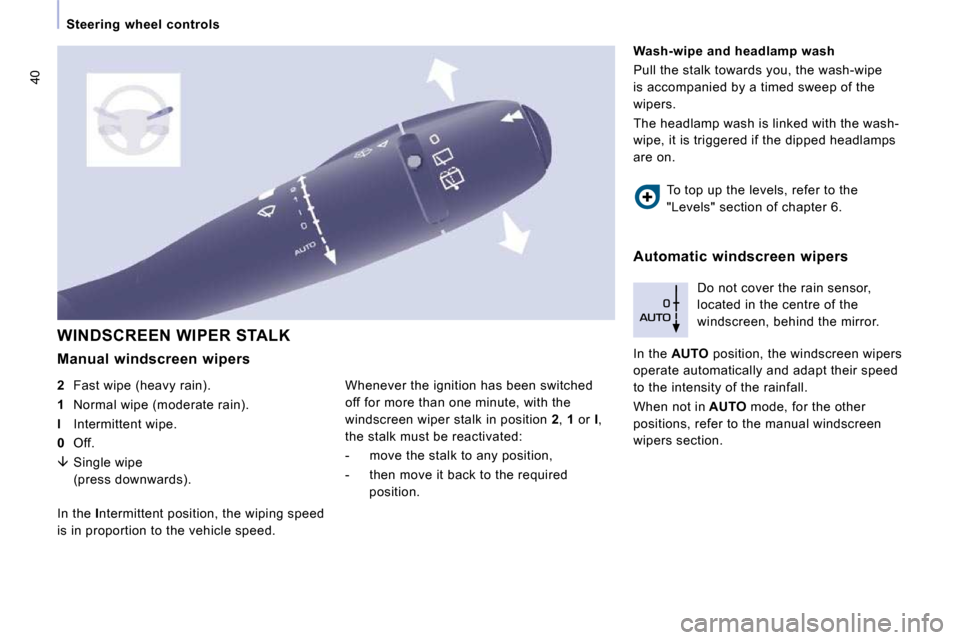
40
Steering wheel controls
WINDSCREEN WIPER STALK
Manual windscreen wipers
2 Fast wipe (heavy rain).
1 Normal wipe (moderate rain).
l Intermittent wipe.
0 Off.
� Single wipe
(press downwards). Do not cover the rain sensor,
located in the centre of the
windscreen, behind the mirror.
Wash-wipe and headlamp wash
Pull the stalk towards you, the wash-wipe
is accompanied by a timed sweep of the
wipers.
The headlamp wash is linked with the wash-
wipe, it is triggered if the dipped headlamps
are on.
In the I ntermittent position, the wiping speed
is in proportion to the vehicle speed. To top up the levels, refer to the
"Levels" section of chapter 6.
In the AUTO position, the windscreen wipers
operate automatically and adapt their speed
to the intensity of the rainfall.
When not in AUTO mode, for the other
positions, refer to the manual windscreen
wipers section.
Whenever the ignition has been switched
off for more than one minute, with the
windscreen wiper stalk in position
2 , 1 or I ,
the stalk must be reactivated:
- move the stalk to any position,
- then move it back to the required position. Automatic windscreen wipers
Page 53 of 226
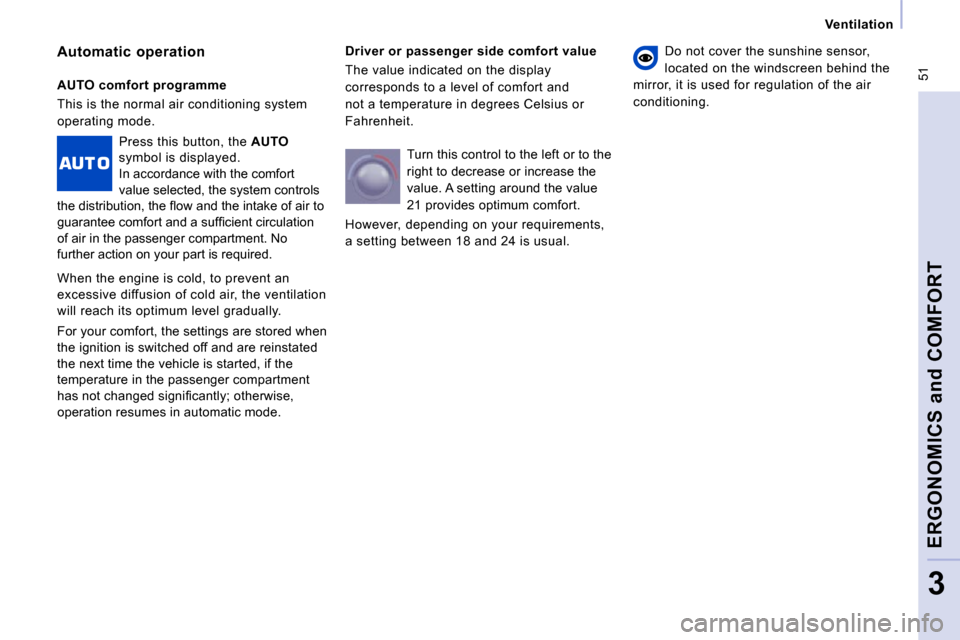
51
Ventilation
ERGONOMICS and COMFORT
3
Driver or passenger side comfort value
The value indicated on the display
corresponds to a level of comfort and
not a temperature in degrees Celsius or
Fahrenheit.
Automatic operation Do not cover the sunshine sensor,
located on the windscreen behind the
mirror, it is used for regulation of the air
conditioning.
AUTO comfort programme
This is the normal air conditioning system
operating mode.
Press this button, the AUTO symbol is displayed. In accordance with the comfort value selected, the system controls �t�h�e� �d�i�s�t�r�i�b�u�t�i�o�n�,� �t�h�e� �fl� �o�w� �a�n�d� �t�h�e� �i�n�t�a�k�e� �o�f� �a�i�r� �t�o� �g�u�a�r�a�n�t�e�e� �c�o�m�f�o�r�t� �a�n�d� �a� �s�u�f�fi� �c�i�e�n�t� �c�i�r�c�u�l�a�t�i�o�n� of air in the passenger compartment. No further action on your part is required.
When the engine is cold, to prevent an excessive diffusion of cold air, the ventilation will reach its optimum level gradually.
For your comfort, the settings are stored when the ignition is switched off and are reinstated the next time the vehicle is started, if the temperature in the passenger compartment �h�a�s� �n�o�t� �c�h�a�n�g�e�d� �s�i�g�n�i�fi� �c�a�n�t�l�y�;� �o�t�h�e�r�w�i�s�e�,� operation resumes in automatic mode.
Turn this control to the left or to the
right to decrease or increase the
value. A setting around the value
21 provides optimum comfort.
However, depending on your requirements,
a setting between 18 and 24 is usual.
Page 72 of 226
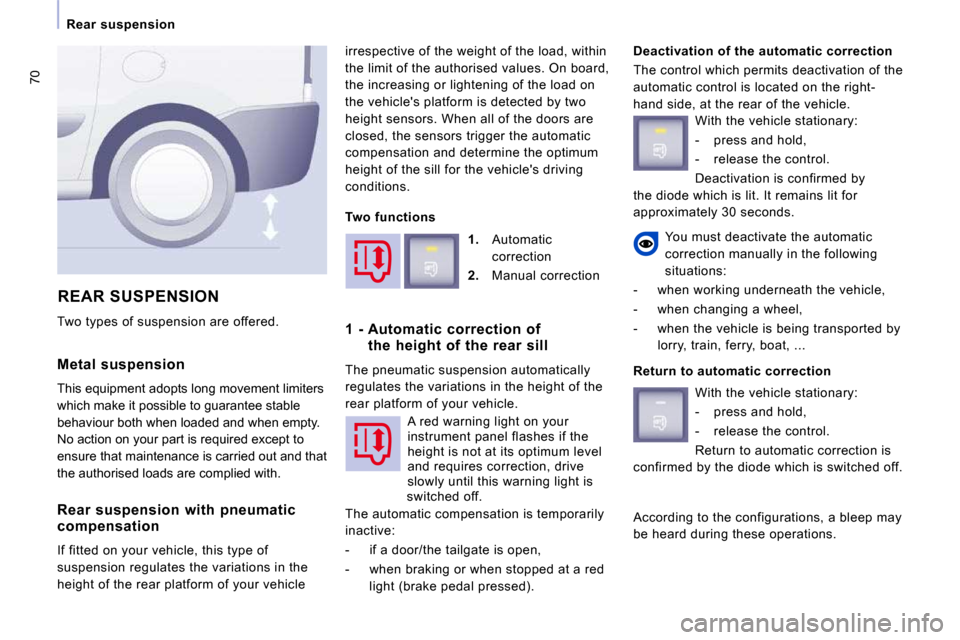
70
Rear suspension
Metal suspension
This equipment adopts long movement limiters
which make it possible to guarantee stable
behaviour both when loaded and when empty.
No action on your part is required except to
ensure that maintenance is carried out and that
the authorised loads are complied with. irrespective of the weight of the load, within
the limit of the authorised values. On board,
the increasing or lightening of the load on
the vehicle's platform is detected by two
height sensors. When all of the doors are
closed, the sensors trigger the automatic
compensation and determine the optimum
height of the sill for the vehicle's driving
conditions.
Deactivation of the automatic correction
The control which permits deactivation of the
automatic control is located on the right-
hand side, at the rear of the vehicle.
REAR SUSPENSION
You must deactivate the automatic
correction manually in the following
situations:
- when working underneath the vehicle,
- when changing a wheel,
- when the vehicle is being transported by lorry, train, ferry, boat, ...
Two types of suspension are offered.
Rear suspension with pneumatic
compensation
If fitted on your vehicle, this type of
suspension regulates the variations in the
height of the rear platform of your vehicle
1. Automatic
correction
2. Manual correction
1 - Automatic correction of the height of the rear sill
The pneumatic suspension automatically
regulates the variations in the height of the
rear platform of your vehicle. A red warning light on your
instrument panel flashes if the
height is not at its optimum level
and requires correction, drive
slowly until this warning light is
switched off.
The automatic compensation is temporarily
inactive:
- if a door/the tailgate is open,
- when braking or when stopped at a red light (brake pedal pressed). With the vehicle stationary:
- press and hold,
- release the control.
Deactivation is confirmed by
the diode which is lit. It remains lit for
approximately 30 seconds.
Return to automatic correction
With the vehicle stationary:
- press and hold,
- release the control.
Return to automatic correction is
confirmed by the diode which is switched off.
According to the configurations, a bleep may
be heard during these operations.
Two functions
Page 79 of 226
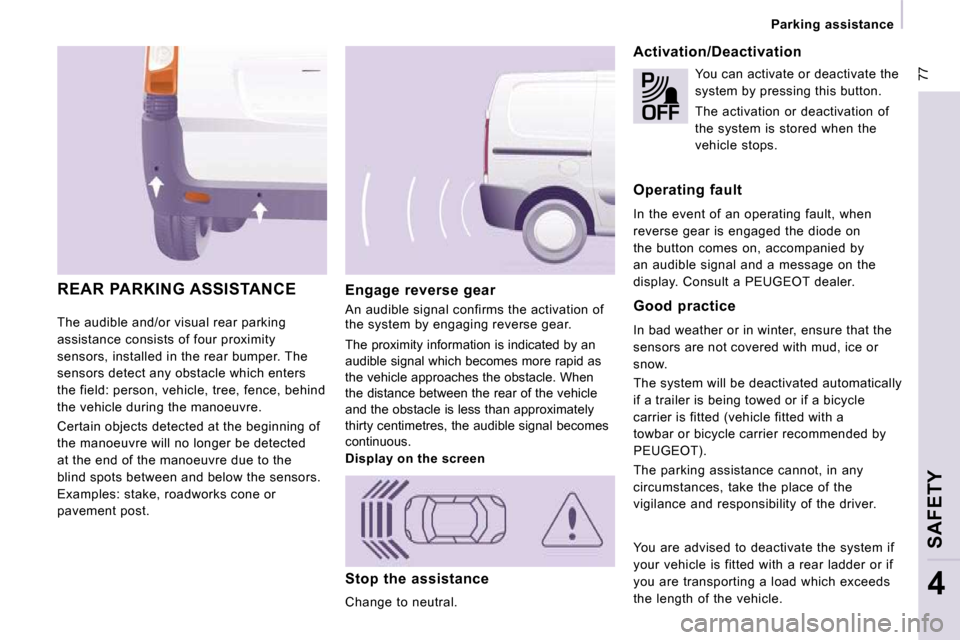
77
Parking assistance
SAFETY
4
The audible and/or visual rear parking
assistance consists of four proximity
sensors, installed in the rear bumper. The
sensors detect any obstacle which enters
the field: person, vehicle, tree, fence, behind
the vehicle during the manoeuvre.
Certain objects detected at the beginning of
the manoeuvre will no longer be detected
at the end of the manoeuvre due to the
blind spots between and below the sensors.
Examples: stake, roadworks cone or
pavement post.
Engage reverse gear
An audible signal confirms the activation of
the system by engaging reverse gear.
The proximity information is indicated by an
audible signal which becomes more rapid as
the vehicle approaches the obstacle. When
the distance between the rear of the vehicle
and the obstacle is less than approximately
thirty centimetres, the audible signal becomes
continuous.
Stop the assistance
Change to neutral.
REAR PARKING ASSISTANCE
Activation/Deactivation
You can activate or deactivate the
system by pressing this button.
The activation or deactivation of
the system is stored when the
vehicle stops.
Operating fault
In the event of an operating fault, when
reverse gear is engaged the diode on
the button comes on, accompanied by
an audible signal and a message on the
display. Consult a PEUGEOT dealer.
Good practice
In bad weather or in winter, ensure that the
sensors are not covered with mud, ice or
snow.
The system will be deactivated automatically
if a trailer is being towed or if a bicycle
carrier is fitted (vehicle fitted with a
towbar or bicycle carrier recommended by
PEUGEOT ).
The parking assistance cannot, in any
circumstances, take the place of the
vigilance and responsibility of the driver.
Display on the screen
You are advised to deactivate the system if
your vehicle is fitted with a rear ladder or if
you are transporting a load which exceeds
the length of the vehicle.
Page 122 of 226
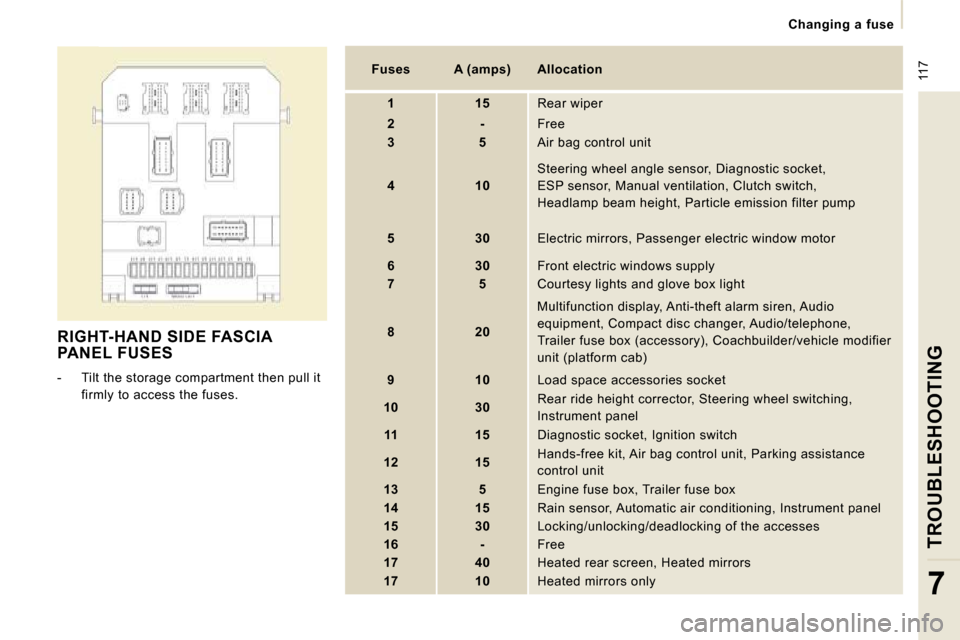
117
Changing a fuse
TROUBLESHOOTING
7
RIGHT-HAND SIDE FASCIA PANEL FUSES
- Tilt the storage compartment then pull it firmly to access the fuses.
Fuses A (amps) Allocation
1 15 Rear wiper
2 - Free
3 5 Air bag control unit
4 10 Steering wheel angle sensor, Diagnostic socket,
ESP sensor, Manual ventilation, Clutch switch,
Headlamp beam height, Particle emission filter pump
5 30 Electric mirrors, Passenger electric window mot or
6 30 Front electric windows supply
7 5 Courtesy lights and glove box light
8 20 Multifunction display, Anti-theft alarm siren, Aud
io
equipment, Compact disc changer, Audio/telephone,
Trailer fuse box (accessory), Coachbuilder/vehicle modifier
unit (platform cab)
9 10 Load space accessories socket
10 30 Rear ride height corrector, Steering wheel switchi
ng,
Instrument panel
11 15 Diagnostic socket, Ignition switch
12 15 Hands-free kit, Air bag control unit, Parking assi
stance
control unit
13 5 Engine fuse box, Trailer fuse box
14 15 Rain sensor, Automatic air conditioning, Instru ment panel
15 30 Locking/unlocking/deadlocking of the accesses
16 - Free
17 40 Heated rear screen, Heated mirrors
17 10 Heated mirrors only